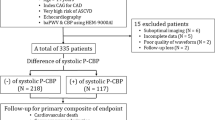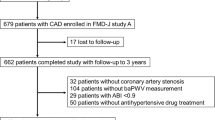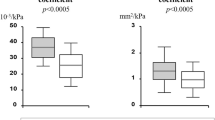Abstract
Pharmacotherapy to protect the arteries may be appropriate for individuals with high-normal blood pressure who are at risk for future cardiovascular disease (CVD). Nebivolol (NEB) in contrast to atenolol (ATE) may have a beneficial effect on endothelial function and may be more effective than ATE in preventing CVD. Sixty subjects with preHTN or borderline BP and abnormal small artery elasticity (SAE) underwent evaluation with 10 tests, including large and small artery elasticity, resting and treadmill exercise BP, carotid intimal-media thickness, retinal vascular photography, micro-albuminuria, electrocardiography, echocardiography, and plasma B-type natriuretic peptide level. Each test scored as normal (0), borderline (1), or abnormal (2), and the total disease score (DS) was calculated by adding the test scores. Subjects were randomized double-blind to placebo (PLAC, n = 22), NEB 5/10 mg/day (n = 20), or ATE 25/50 mg/day (n = 18) once daily for 9 months. After 9 months, in the group receiving NEB the mean (standard deviation) DS decreased from baseline 4.3 (2.6) to 2.8 (2.4) (P < 0.007), with ATE from 5.4 (2.5) to 3.5 (1.9) (P = 0.0006), and with PLAC from 5.2 (3.0) to 4.5 (2.6) (P = 0.18). SAE increased in the NEB group from 6.0 (2.2) to 8.4 (3.4) ml/mmHg × 100 (P = 0.0001), whereas there was no significant change in the ATE and PLAC groups. Thus, nebivolol improves small artery function more than atenolol in asymptomatic subjects with preHTN or borderline BP, despite their similar BP-lowering effect.
This is a preview of subscription content, access via your institution
Access options
Subscribe to this journal
Receive 12 digital issues and online access to articles
$119.00 per year
only $9.92 per issue
Buy this article
- Purchase on Springer Link
- Instant access to full article PDF
Prices may be subject to local taxes which are calculated during checkout
Similar content being viewed by others
References
Blood Pressure Lowering Treatment Trialists’ Collaboration, Sundström J, Arima H, Woodward M, Jackson R, Karmali K, Lloyd-Jones D, et al. Blood pressure lowering treatment based on cardiovascular risk: a meta-analysis of individual patient data. Lancet 2014;384:591–8.
Czernichow S, Zanchetti A, Turnbull F, Barzi F, Ninomiya T, Kengne AP, et al Blood Pressure Lowering Treatment Trialists’ Collaboration. The effects of blood pressure reduction and of different blood pressure- lowering regimens on major cardiovascular events according to baseline blood pressure: meta-analysis of randomized trials. J Hypertens. 2011;29:4–16.
SPRINT Research Group, Wright JT Jr, Williamson JD, Whelton PK, Snyder JK, Sink KM, Rocco MV, et al. A randomized trial of intensive versus standard blood-pressure control. N Engl J Med. 2015;373:2103–16.
ACCORD Study Group, Cushman WC, Evans GW, Byington RP, Goff DC Jr, Grimm RH Jr, Cutler JA, et al. Effects of intensive blood-pressure control in type 2 diabetes mellitus. N Engl J Med. 2010;362:1575–785.
Lonn EM, Bosch J, Lopez-Jaramillo P, Zhu J, Liu L, Pais P, et al. Blood-pressure lowering in intermediate-risk persons without cardiovascular disease. N Engl J Med. 2016;374:2009–20.
Vasan RS, Larson MG, Leip EP, Evans JC, O’Donnell CJ, Kannel WB, et al. Impact of high-normal blood pressure on the risk of cardiovascular disease. N Engl J Med. 2001;345:1291–7.
Ettehad D, Emdin CA, Kiran A, Anderson SG, Callender T, Emberson J, et al. Blood pressure lowering for prevention of cardiovascular disease and death: a systematic review and meta-analysis. Lancet 2016;387:957–67.
Cohn JN, Hoke L, Whitwam W, Sommers PA, Taylor AL, Duprez D, et al. Screening for early detection of cardiovascular disease in asymptomatic individuals. Am Heart J. 2003;146:679–85.
Duprez DA, Cohn JN. Identifying early cardiovascular disease to target candidates for treatment. J Clin Hypertens. (Greenwich) 2008;10:226–31.
Duprez DA, Florea N, Zhong W, Grandits GA, Hawthorne CK, Hoke L, et al. Vascular and cardiac functional and structural screening to identify risk of future morbid events: preliminary observations. J Am Soc Hypertens. 2011;5:401–09.
James PA, Oparil S, Carter BL, Cushman WC, Dennison-Himmelfarb C, Handler J, et al. Evidence-based guideline for the management of high blood pressure in adults: report from the panel members appointed to the Eighth Joint National Committee (JNC 8). JAMA 2014;311:507–20.
Mancia G, Fagard R, Narkiewicz K, Redón J, Zanchetti A, Böhm M, et al. ES2013 ESH/ESC Guidelines for the management of arterial hypertension: the Task Force for the management of arterial hypertension of the European Society of Hypertension (ESH) and of the European Society of Cardiology (ESC). J Hypertens. 2013;31:1925–38.
Fongemiel J, Felix-Getzik E. A review of nebivolol pharmacology and clinical evidence. Drugs 2015;75:1349–71.
Munzel T, Gori T. Nebivolol: the somewhat-different beta- adrenergic receptor blocker. J Am Coll Cardiol. 2009;54:1491–9.
Maffei A, Vecchione C, Aretini A, Poulet R, Bettarini U, Gentile MT, et al. Characterization of nitric oxide release by nebivolol and its metabolites. Am J Hypertens. 2006;19:579–86.
Cockcroft J, Chowienczyk P, Brett S, Chen C, Dupont A, Nueten L, et al. Nebivolol vasodilates human forearm vasculature: evidence for an L-arginine/NO-dependent mechanism. J Pharmacol Exp Ther. 1995;274:1067–71.
Gilani M, Kaiser DR, Bratteli CW, Alinder C, Rajala S, Bank AJ, et al. Role of nitric oxide deficiency and its detection as a risk factor in pre-hypertension. J Am Soc Hypertens. 2007;1:45–55.
Finkelstein SM, Collins VR, Cohn JN. Arterial vascular compliance response to vasodilators by Fourier and pulse contour analysis. Hypertension 1988;12:380–7.
Diehl KJ, Stauffer BL, Dow CA, Bammert TD, Brunjes DL, Greiner JJ, et al. Chronic nebivolol treatment suppresses endothelin-1-mediated vasoconstrictor tone in adults with elevated blood pressure. Hypertension 2016;67:1196–204.
Neuman RB, Hayek SS, Poole JC, Rahman A, Menon V, Kavtaradze N, et al. Nitric oxide contributes to vasomotor tone in hypertensive African Americans treated with nebivolol and metoprolol. J Clin Hypertens. (Greenwich) 2016;18:223–31.
Mason RP, Jacob RF, Corbalan JJ, Szczesny D, Matysiak K, Malinski T. The favorable kinetics and balance of nebivolol-stimulated nitric oxide and peroxynitrite release in human endothelial cells. BMC Pharmacol Toxicol. 2013;14:48 https://doi.org/10.1186/2050-6511-14-48.5.
Duprez DA, Jacobs DR Jr, Lutsey PL, Bluemke DA, Brumback LC, Polak JF, et al. Association of small artery elasticity with incident cardiovascular disease in older adults: the multi-ethnic study of atherosclerosis. Am J Epidemiol. 2011;174:528–36.
Peralta CA, Adeney KL, Shlipak MG, Jacobs D Jr, Duprez D, Bluemke D, et al. Structural and functional vascular alterations and incident hypertension in normotensive adults: the Multi-Ethnic Study of Atherosclerosis. Am J Epidemiol. 2010;171:63–71.
Peralta CA, Jacobs DR Jr, Katz R, Ix JH, Madero M, Duprez DA, et al. Association of pulse pressure, arterial elasticity, and endothelial function with kidney function decline among adults with estimated GFR>60 mL/min/1.73m2: the Multi-Ethnic Study of Atherosclerosis (MESA). Am J Kidney Dis. 2012;59:41–9.
Saul SM, Duprez DA, Zhong W, Grandits GA, Cohn JN. Effect of carvedilol, lisinopril and their combination on vascular and cardiac health in patients with borderline blood pressure: the DETECT Study. J Hum Hypertens. 2013;27:362–7.
Acknowledgements
The EVIDENCE study was funded by a research grant from FOREST Laboratories. The study design was developed independently from FOREST Laboratories. The EVIDENCE study has been registered in ClinicalTrials.gov as NCT01522950.
Author information
Authors and Affiliations
Corresponding author
Ethics declarations
Conflict of interest
Daniel A. Duprez has received research grants from Pfizer, Regeneron, Astra-Zeneca and Novartis. Jay N. Cohn has received a research grant form Forest Laboratories; he is an equity partner in CVC-HD, LLC. The remaining authors declare that they have no competing interests.
Rights and permissions
About this article
Cite this article
Duprez, D.A., Florea, N., Duval, S. et al. Effect of nebivolol or atenolol vs. placebo on cardiovascular health in subjects with borderline blood pressure: the EVIDENCE study. J Hum Hypertens 32, 20–25 (2018). https://doi.org/10.1038/s41371-017-0019-9
Received:
Revised:
Accepted:
Published:
Issue Date:
DOI: https://doi.org/10.1038/s41371-017-0019-9



